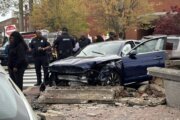LUIS ANDRES HENAO
Associated Press
SANTIAGO, Chile (AP) — Chilean officials said Thursday they have arrested three members of an anarchist cell suspected in the country’s worst bomb attack in more than two decades, focusing new attention on a loose-knit movement that has attracted thousands while alarming authorities.
One of the suspects is believed to have carried out the attack while two others were accomplices, said Interior and Security Minister Rodrigo Penailillo, who did not release their names. Local media quoted defense lawyer Eduardo Camus as saying the three suspects deny any wrongdoing.
The lunchtime explosion on Sept. 8 scattered shrapnel across a crowded underground shopping area connected to a subway station, injuring 14 people and shocking Chileans who until then had grown uneasily accustomed to a drumbeat of small, nighttime bombs that caused little damage.
Attorney General Sabas Chahuan said the suspects are members of an “enclosed anarchist cell,” without mentioning groups or possible motives. Officials said the three also are suspected of involvement in the planting of a bomb at another subway station in Santiago on July 12 that caused material damage but no injuries.
A declaration published Thursday on an anarchist website in the name of a faction of the “Conspiracy of the Cells of Fire” claimed responsibility for both attacks, but insisted the group had tried to avoid casualties.
“We called (the emergency number) more than 10 minutes before the blast, waiting for police to react by evacuating, but they ignored it, detonating the device and causing several injuries, which we lament. Our target was not consumers or workers, but the structures, properties and enforcers of power.”
It described the target as “a shopping mall for the bourgeoisie.”
Groups calling themselves Conspiracy of the Cells of Fire operate in several countries. The U.S. State Department has labelled a Greek wing of the movement as a terrorist organization.
This month’s blast was the first of some 200 bombings over the past decade known to have caused serious injury to bystanders in what is otherwise one of Latin America’s safest capitals.
Authorities have attributed many of those attacks to anarchist splinter groups. Some have claimed responsibility for the homemade bombs over the years with demands ranging from an end of U.S. intervention in Afghanistan to the release of Chilean anarchists jailed for a bomb attack in Spain.
Many of the attacks involved the same sort of bomb: a fire extinguisher partly filled with gunpowder. But the only known death, and only other serious injury, had been suffered by two self-described anarchists suspected of trying to plant bombs.
Mauricio Morales, a 27-year old university student, was killed when a bomb he was carrying in a backpack blew up in 2009. Twenty-two-year old Luciano Pitronello lost one hand when a bomb he was carrying exploded outside a bank. He was later absolved of terrorism, but was convicted and sentenced to house arrest for driving with a false license plate and carrying explosives.
“The incidents in which we have seen bomb attacks have involved people connected to the anarchism world,” said Mauricio Fernandez, director of the anti-crime unit in the attorney general’s office. “It’s not a minor connection.”
Fernandez said that members of the more violent groups are typically in their 20s, and often blend with peaceful anarchists in buildings taken over by Chile’s wing of the international squatter movement.
The Sept. 8 bombing also prompted criticism from some anarchists, who differ on the sort and extent of violence needed to overthrow what they see as oppressive local and global power structures.
“Anarchism is a response of the oppressed class to the injustices of capitalism. That’s why no anarchist action can be directed toward harming workers,” the Anarchist Revolution Current wrote on its Facebook page. “We repudiate the explosion in the shopping area next to the subway station.”
In Chile as in much of the world, anarchism emerged in the 19th century and had a key role in the labor movement, said Sergio Grez, a professor of history at the University of Chile and author of “Anarchists and the Worker’s Movement.”
Its influence began to wane after the governments passed laws protecting workers and orthodox Marxists grew stronger. But the movement has resurged in recent years.
In Chile, some anarchist groups have often turned otherwise peaceful protests into battlegrounds in the streets by throwing rocks, gas bombs and even acid at police.
Melissa Sepulveda, an anarchist and president of the University of Chile student federation has denounced the protest violence, as well as denying students might have links to the September bombing.
Grez expressed skepticism that anarchists were involved with the bombing since an attack that injures ordinary citizens would be out of character for people who embrace the working class and ordinary citizens.
“To conflate anarchism and terrorism is not just a profound historical mistake but a politically motivated one as well,” Grez said.
___
Luis Andres Henao on Twitter: https://twitter.com/LuisAndresHenao
Copyright 2014 The Associated Press. All rights reserved. This material may not be published, broadcast, rewritten or redistributed.







